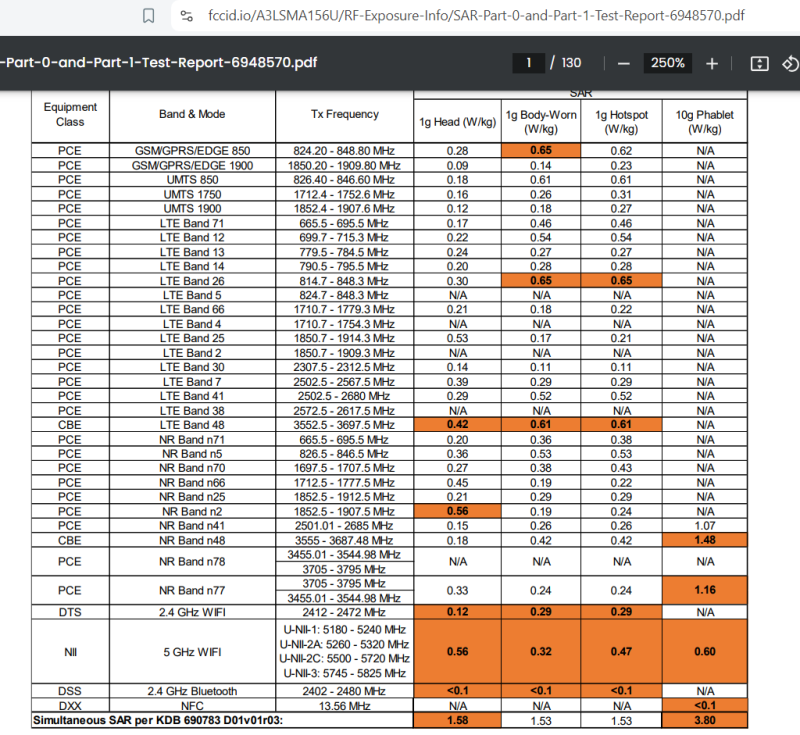Samsung Galaxy A15 SAR Level Summary
RF Safe® QuantaCase Samsung Galaxy A15 5g EMF Blocking Anti-Radiation Phone Case
$45.47
The cellular transmission SAR values for the Samsung Galaxy A15 (FCC ID A3LSMA156U) are detailed below based on the provided chart. The highest values for each test position are highlighted.

Cellular Transmission SAR Values:
- 1g Head (W/kg): 0.56 (NR Band n77)
- 1g Body-Worn (W/kg): 0.65 (LTE Band 41)
- 1g Hotspot (W/kg): 1.16 (NR Band n77)
Simultaneous Transmission SAR Values:
- 1g Head (W/kg): 1.58
- 1g Body-Worn (W/kg): 1.53
- 1g Hotspot (W/kg): 1.53
- 10g Phablet (W/kg): 3.80
Samsung Galaxy A15 SAR Values and Safety Concerns
The Samsung Galaxy A15 has been approved by the FCC under ID A3LSMA156U with specific SAR (Specific Absorption Rate) values indicating the levels of radiofrequency energy absorbed by the body during cellular transmission. This blog post aims to summarize these SAR values and highlight the critical discussion surrounding the safety guidelines set by the FCC, which many experts believe are outdated and fail to account for non-thermal risks associated with prolonged exposure to radiofrequency radiation, especially for children.
SAR Levels for Samsung Galaxy A15
The SAR values for the Samsung Galaxy A15 show varying levels of absorption depending on the frequency and the mode of operation. The highest SAR values recorded are 0.56 W/kg for 1g Head, 0.66 W/kg for 1g Body-Worn positions for LTE Band 41, and 1.16 W/kg for 1g Hotspot position for NR Band n77. The simultaneous transmission SAR values are 1.58 W/kg at the head, 1.53 W/kg when worn on the body, and 1.53 W/kg for hotspot. The highest 10g Phablet SAR value recorded is 3.80 W/kg for simultaneous transmission.
Understanding SAR Values: 1g vs. 10g Tests
What is SAR?
SAR (Specific Absorption Rate) measures the rate at which the body absorbs RF (radiofrequency) energy from a mobile device. It is expressed in watts per kilogram (W/kg). SAR values help ensure that mobile devices comply with safety standards set by regulatory authorities, such as the FCC in the United States.
1g vs. 10g Tests:
- 1g SAR Test: The 1g SAR test measures the RF energy absorbed by 1 gram of body tissue. This test provides a higher resolution measurement and is particularly useful for identifying localized hotspots where RF absorption is higher.
- 10g SAR Test: The 10g SAR test measures the RF energy absorbed by 10 grams of body tissue. This test averages the absorption over a larger volume, which can provide a broader view of the device’s safety profile but may not capture localized hotspots as effectively as the 1g test.
Phablet SAR Testing
The term “phablet” refers to a device that is larger than a typical smartphone but smaller than a tablet. In SAR testing, the “Phablet” position typically refers to how the device is held or carried close to the body, such as in a bag, purse, or pocket, where it may come into close contact with body tissues for prolonged periods.
10g Phablet SAR Value for Samsung Galaxy A15
The highest 10g Phablet SAR value recorded for the Samsung Galaxy A15 is 3.80 W/kg for Simultaneous Transmission.
FCC’s Outdated Guidelines
The FCC’s SAR guidelines, established in the 1990s, have come under scrutiny for not reflecting the latest scientific understanding of the health impacts of RF radiation. These guidelines primarily focus on thermal effects, the heating of tissue due to RF energy, while ignoring substantial research indicating non-thermal biological effects.
Legal and Scientific Backdrop
In a landmark case, the FCC lost a lawsuit regarding its outdated SAR guidelines. The court ruled that the FCC failed to consider non-thermal risks and the unique vulnerability of children to RF radiation. This ruling underscores the urgent need to revise safety standards to better protect public health.
National Toxicology Program (NTP) Findings
Adding to the concern, the NTP’s research found clear evidence of cancer linked to cell phone radiation. Despite these findings, the Biden administration redirected funding from the NTP’s wireless radiation research to military purposes. This decision has sparked outrage, especially since President Biden’s son, Beau Biden, died from brain cancer, a condition potentially linked to RF exposure.
Supporting Evidence and Research
Numerous studies have pointed to the non-thermal effects of RF radiation, which are not considered in the current FCC guidelines. Research has shown biological interactions such as DNA damage, oxidative stress, and increased cancer risk. The FDA-approved TheraBionic treatment, which uses RF-EMF for cancer therapy, further highlights the biological impact of non-thermal RF radiation.
Protecting Our Children
Children are particularly vulnerable to RF radiation due to their developing bodies and thinner skulls. The current SAR guidelines do not differentiate between adults and children, putting the younger population at greater risk. There is an urgent need for more stringent safety standards and continued research into the non-thermal effects of RF radiation to ensure the safety of all users, especially children.
Conclusion
The Samsung Galaxy A15, like many modern smartphones, has SAR values that warrant careful consideration, especially in light of recent legal and scientific developments. The outdated FCC guidelines fail to account for non-thermal risks and do not adequately protect children. It is imperative for consumers to stay informed and advocate for updated safety standards to minimize exposure to potentially harmful RF radiation.
Call to Action
We urge the public to demand updated FCC guidelines that reflect current scientific knowledge and protect the most vulnerable. Additionally, supporting continued research into RF radiation’s health effects is crucial for ensuring long-term safety.